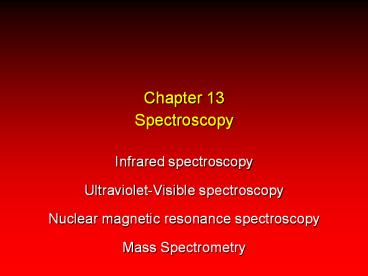Chapter 13 Spectroscopy - PowerPoint PPT Presentation
Title:
Chapter 13 Spectroscopy
Description:
Principles of Molecular Spectroscopy: Quantized Energy States ... the energy difference between. two nuclear spin states. which is proportional to ... – PowerPoint PPT presentation
Number of Views:165
Avg rating:3.0/5.0
Title: Chapter 13 Spectroscopy
1
Chapter 13Spectroscopy
- Infrared spectroscopy
- Ultraviolet-Visible spectroscopy
- Nuclear magnetic resonance spectroscopy
- Mass Spectrometry
2
13.1Principles of Molecular SpectroscopyElectr
omagnetic Radiation
3
Electromagnetic Radiation
- is propagated at the speed of light
- has properties of particles and waves
- the energy of a photon is proportional to its
frequency
4
Figure 13.1 The Electromagnetic Spectrum
Longer Wavelength (l)
Shorter Wavelength (l)
400 nm
750 nm
Visible Light
Higher Frequency (n)
Lower Frequency (n)
Higher Energy (E)
Lower Energy (E)
5
Figure 13.1 The Electromagnetic Spectrum
Longer Wavelength (l)
Shorter Wavelength (l)
Ultraviolet
Infrared
Higher Frequency (n)
Lower Frequency (n)
Higher Energy (E)
Lower Energy (E)
6
Figure 13.1 The Electromagnetic Spectrum
- Cosmic rays
- g Rays
- X-rays
- Ultraviolet light
- Visible light
- Infrared radiation
- Microwaves
- Radio waves
Energy
7
13.2Principles of Molecular Spectroscopy
Quantized Energy States
8
DE hn
- Electromagnetic radiation is absorbed when
theenergy of photon corresponds to difference in
energy between two states.
9
What Kind of States?
- electronic
- vibrational
- rotational
- nuclear spin
UV-Vis infrared microwave radiofrequency
10
13.3Introduction to 1H NMR Spectroscopy
11
The nuclei that are most useful toorganic
chemists are
- 1H and 13C
- both have spin 1/2
- 1H is 99 at natural abundance
- 13C is 1.1 at natural abundance
12
Nuclear Spin
- A spinning charge, such as the nucleus of 1H or
13C, generates a magnetic field. The magnetic
field generated by a nucleus of spin 1/2 is
opposite in direction from that generated by a
nucleus of spin 1/2.
13
The distribution of nuclear spins is random in
the absence of an external magnetic field.
14
An external magnetic field causes nuclear
magnetic moments to align parallel and
antiparallel to applied field.
H0
15
There is a slight excess of nuclear magnetic
moments aligned parallel to the applied field.
H0
16
Energy Differences Between Nuclear Spin States
DE '
DE
increasing field strength
- no difference in absence of magnetic field
- proportional to strength of external magnetic
field
17
Some important relationships in NMR
- The frequency of absorbedelectromagnetic
radiationis proportional to - the energy difference betweentwo nuclear spin
stateswhich is proportional to - the applied magnetic field
18
Some important relationships in NMR
Units
- The frequency of absorbedelectromagnetic
radiationis proportional to - the energy difference betweentwo nuclear spin
stateswhich is proportional to - the applied magnetic field
Hz
kJ/mol(kcal/mol)
tesla (T)
19
Some important relationships in NMR
- The frequency of absorbed electromagneticradiatio
n is different for different elements, and for
different isotopes of the same element. - For a field strength of 4.7 T 1H absorbs
radiation having a frequency of 200 MHz (200 x
106 s-1) 13C absorbs radiation having a
frequency of 50.4 MHz (50.4 x 106 s-1)
20
Some important relationships in NMR
- The frequency of absorbed electromagneticradiati
on for a particular nucleus (such as 1H)depends
on its molecular environment. This is why NMR
is such a useful toolfor structure determination.
21
13.4Nuclear Shieldingand1H Chemical Shifts
- What do we mean by "shielding?"
- What do we mean by "chemical shift?"
22
Shielding
- An external magnetic field affects the motion of
the electrons in a molecule, inducing a magnetic
field within the molecule.
H 0
23
Shielding
- An external magnetic field affects the motion of
the electrons in a molecule, inducing a magnetic
field within the molecule. - The direction of the induced magnetic field is
opposite to that of the applied field.
H 0
24
Shielding
- The induced field shields the nuclei (in this
case, C and H) from the applied field. - A stronger external field is needed in order for
energy difference between spin states to match
energy of rf radiation.
H 0
25
Chemical Shift
- Chemical shift is a measure of the degree to
which a nucleus in a molecule is shielded. - Protons in different environments are shielded
to greater or lesser degrees they have
different chemical shifts.
H 0
26
UpfieldIncreased shielding
DownfieldDecreased shielding
(CH3)4Si (TMS)
Chemical shift (d, ppm)measured relative to TMS
27
d 7.28 ppm
Chemical shift (d, ppm)
28
13.5Effects of Molecular Structureon1H
Chemical Shifts
- protons in different environments experience
different degrees of shielding and have different
chemical shifts
29
Electronegative substituents decreasethe
shielding of methyl groups
- CH3F d 4.3 ppm
- CH3OCH3 d 3.2 ppm
- CH3N(CH3)2 d 2.2 ppm
- CH3CH3 d 0.9 ppm
- CH3Si(CH3)3 d 0.0 ppm
30
Electronegative substituents decreasethe
shielding of methyl groups
- CH3F d 4.3 ppm least shielded H
- CH3OCH3 d 3.2 ppm
- CH3N(CH3)2 d 2.2 ppm
- CH3CH3 d 0.9 ppm
- CH3Si(CH3)3 d 0.0 ppm most shielded H
31
Effect is cumulative
- CHCl3 d 7.3 ppm
- CH2Cl2 d 5.3 ppm
- CH3Cl d 3.1 ppm
32
Protons attached to sp2 hybridized carbonare
less shielded than those attachedto sp3
hybridized carbon
CH3CH3
d 7.3 ppm
d 5.3 ppm
d 0.9 ppm
33
Table 13.1 (p 496)
Type of proton
Chemical shift (d),ppm
Type of proton
Chemical shift (d),ppm
2.5
R
0.9-1.8
Ar
2.3-2.8
1.6-2.6
H
4.5-6.5
2.1-2.5
C
34
Table 13.1 (p 496)
Type of proton
Chemical shift (d),ppm
Type of proton
Chemical shift (d),ppm
3.1-4.1
6.5-8.5
Br
2.7-4.1
9-10
3.3-3.7
2.2-2.9
35
Table 13.1 (p 496)
Type of proton
Chemical shift (d),ppm
1-3
0.5-5
6-8
10-13































